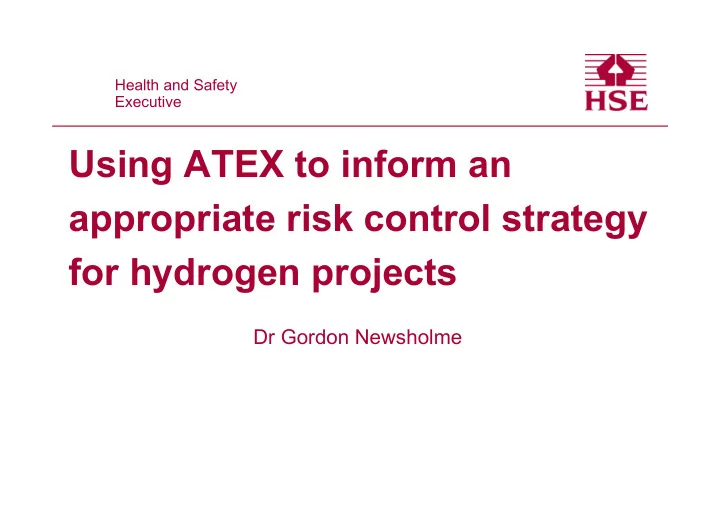

Health and Safety Health and Safety Executive Executive Using ATEX to inform an appropriate risk control strategy for hydrogen projects Dr Gordon Newsholme
Presentation overview • The ATEX Directives • Hazards of hydrogen • Risk management strategy • Practical approaches to risk management • Sources of advice and guidance • Questions
ATEX directives • ATEX 95 (94/9/EC) • ATEX 137 (1999/92/EC)
ATEX 95 (94/9/EC) • Known as ATEX Equipment or Product Directive • Facilitated single market for the supply of products for use in potentially explosive atmospheres • ATEX 95 was implemented in UK by the “ Equipment and Protective Systems for Use in Potentially Explosive Atmospheres Regulations 1996” (EPS) • EPS Regulations mainly enforced by DTI
ATEX 137 (1999/92/EC) • Frequently referred to as the ATEX User Directive • Assures worker safety in workplaces where potentially explosive atmospheres may be present • Places expectations on dutyholders • ATEX 137 was implemented in the UK by the “ Dangerous Substances and Explosive Atmospheres Regulations 2002 ” (DSEAR)
ATEX User Directive philosophy • Are flammable substances present? • Can sufficient dispersal occur to give an explosive mixture? • Is the formation of an explosive mixture possible? • Is the formation of explosive atmospheres reliably prevented? • No?, further measures necessary.
Risk management strategy • Recognise, understand and prioritize the hazards • Identify those scenarios that generate the big risks • Demonstrate you have a plan to manage the risks • Show your plan follows a suitable hierarchy • Don’t forget the boring, old fashioned risks!
Health and Safety Health and Safety Executive Executive Practical approaches to risk management
ATEX risk management hierarchy • Eliminate the risk (replace the dangerous substances) • Control the risk • Reduce the inventory of dangerous substances • Avoid/control releases • Prevent flammable atmospheres forming • Avoid ignition sources • Control access • Mitigate the risk • Reduce the number of people at risk • Provide explosion relief, suppression or containment
Avoiding the formation of flammable mixtures • Containment • Location of the installation and equipment orientation • Ventilation
Containment • Design and construct to an appropriate code • Use suitable materials • Minimise the number of joints • Use welded or brazed joints when practicable • Minimise the use of threaded or flanged joints • Avoid compression joints • Leak test in an appropriate manner
Location, location, location • Locate H 2 storage/handling equipment outside • Beware of ceilings, covers, canopies and roofs
Equipment orientation Let the buoyancy of hydrogen work for you!
Ventilation • Estimate the maximum foreseeable leak rate (MFLR) • Provide adequate high and low level ventilation • Ventilation must dilute MFLR below 10% LEL • Use CFD for complex ventilation requirements
Avoiding sources of ignition • Carry out a hazardous area classification • Aim to locate electrics in non-hazardous zones • Use appropriate electrics in hazardous zones • Control hot work, smoking, mobile phones etc • Use bonding, earthing and anti-static clothing • Consider protection against lightning
Security and access control • Security provisions should be appropriate to location • Appropriate balance between ventilation & security • Perception of Regulator is likely to exceed the real risk • “Precautionary principle” should be used
Explosion mitigation • Relief • Containment • Suppression
Information and guidance • HSG 243: Fuel cells; understand the hazards, control the risks • European Industrial Gases Assoc. (IGC Doc 15/05E) • NASA (Safety std for hydrogen & hydrogen systems) • ISO/DPAS 15916: Safety of hydrogen systems • NFPA 50A: Standard for gaseous hydrogen systems • ATEX (supply) Regs; SI192,1996 • HSE DSEAR ACOPs (L134-138 inc) • BS EN 60079 Electrical app. for explosive gas atms
That’s all folks!
Questions ? Gordon Newsholme
Acknowledgements • Jem Sullivan: hydrogen man cartoon • Fuel Cells Canada: selected images
Health and Safety Health and Safety Executive Executive Workshop Dr Gordon Newsholme
Programme Each team should: • select an assignment from those available • Prepare a 10 - 15 minute PowerPoint presentation • Ensure that at least 3 presenters are involved
Workshop assignments (1) There are two types of assignment to chose from: 1. Design proposals Analyse the brief Identify the key safety challenges Assess the risks Prepare a risk management strategy Produce a design Identify the operational needs to underpin the design Prepare the presentation
Workshop assignments (2) 2. Assessment of the installation Analyse the description of the installation Identify the key issues of the design, location etc Consider whether ‘good practice’ has been used Assess the risks to safety from the installation Identify what changes you would suggest/demand Prepare the presentation
Design proposal assignment 1 Hydrogen powered canal boat
Commercial sight-seeing canal boat The client would like the design to include: • The H 2 fuel cell should be visible to the passengers • A large all-weather sight-seeing salon • Facilities for providing light refreshments • Infrequent refuelling • City/town centre overnight berthing
H 2 fuel cell/electrolyser installation The installation will provide domestic electricity base load (5 kW) and will include: • Wind powered electricity generator • Hydrogen storage • Underground fuel cell, electrolyser, controls etc.
Installation assessment assignment The installation is a UPS system based on H 2 fuel: • Fuel cell & controls are located in open plan office • High pressure hydrogen storage located outside • Hydrogen cylinders located in dedicated cabinet
Recommend
More recommend